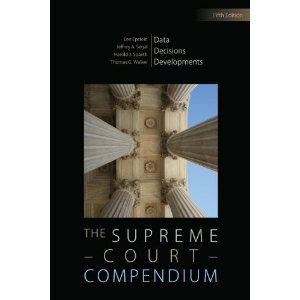In light of the recent frenzy of activity surrounding the U.S. Supreme Court and its string of important decisions (ranging from its Affordable Care Act decision to the immigration issues raised in Arizona v. United States) many students, faculty and staff have become interested in the metaphorical batting averages, ERAs and RBIs of the Court. All baseball analogies aside, Supreme Court statistics including voting records and the number and type of cases accepted by the court, have become incredibly valuable for both litigators and researchers alike.
Journal of the Supreme Court of the United States
The Journal of the Supreme Court of the United States contains the “official minutes” of the Court. Published on a rolling basis for every-day the Court issues orders and decisions,
[t]he Journal reflects the disposition of each case, names the court whose judgment is under review, lists the cases argued that day and the attorneys who presented oral argument, contains miscellaneous announcements by theChief Justice from the Bench, and sets forth the names of attorneys admitted to the Bar of the Supreme Court. It does not contain the opinions of the Court, which are published in the United States Reports.
There is an approximate two week delay for publication, however, the website currently has links to the full-text of each journal dating back from the October 1993 term to the present.
For the past several years, SCOTUSblog has been producing mid and end-of-term analysis for the Supreme Court. Called “Stat Packs” the analysis is broken out into 23 separate and distinct categories summarizing key statistical trends of the Court. Analysis dating back to 1995 is provided by Thomas C. Goldstein, the Publisher and co-founder of Scotusblog, a prominent attorney and law professor. The blog released its summary of the Court’s most recent term on June 30, 2012, available here. Analysis of previous terms can be accessed from the Blog’s Stat Pack Archive available here.
 The Supreme Court Database funded by the National Science Foundation, developed in the mid-1980s by Harold J. Spaeth Research Professor of Law at Michigan State University College of Law has statistical data sets on the decisions of the Supreme Court from the 1953 term through to the present (currently 2010). The ultimate goal of the project is to provide coverage dating back to the Court’s first reported decision in, Georgia v. Brailsford (1792)).
The Supreme Court Database funded by the National Science Foundation, developed in the mid-1980s by Harold J. Spaeth Research Professor of Law at Michigan State University College of Law has statistical data sets on the decisions of the Supreme Court from the 1953 term through to the present (currently 2010). The ultimate goal of the project is to provide coverage dating back to the Court’s first reported decision in, Georgia v. Brailsford (1792)).
Today’s version of the Database houses 247 pieces of information for each case, roughly broken down into six categories: (1) identification variables (e.g., citations and docket numbers); (2) background variables (e.g., how the Court took jurisdiction, origin and source of the case, the reason the Court agreed to decide it); (3) chronological variables (e.g., the date of decision, term of Court, natural court); (4) substantive variables (e.g., legal provisions, issues, direction of decision); (5) outcome variables (e.g., disposition of the case, winning party, formal alteration of precedent, declaration of unconstitutionality); and (6) voting and opinion variables (e.g., how the individual justices voted, their opinions and interagreements).
Although not terribly user friendly, the database provides the unique ability to search for information simultaneously across multiple variables including judicial terms and categories.
Books and Journals
 Lee Epstein, The Supreme Court Compendium: Data, Decisions, and Developments (5th ed. 2012). Available here from the Pace Law Library Catalog.
Lee Epstein, The Supreme Court Compendium: Data, Decisions, and Developments (5th ed. 2012). Available here from the Pace Law Library Catalog.
Albert P. Blaustein & Roy M. Mersky, The First One Hundred Justices: Statistical Studies on the Supreme Court of the United States (1978). Available here from the Pace Law Library Catalog.
The Harvard Law Review provides a statistical breakdown of the Justices voting records in their November issues. Available in print from the Pace Law Library Catalog or online.
References:
Jill Ann Duffy & Elizabeth Ardella Laub Lambert, Sup. Ct. Historical Soc’ Pubs., Researching the Supreme Court of the United States: Available Resources for Commonly-Asked Questions (2008), available at http://www.supremecourthistory.org/supremecourthistory/inc/schs_researching-the-court.pdf.
